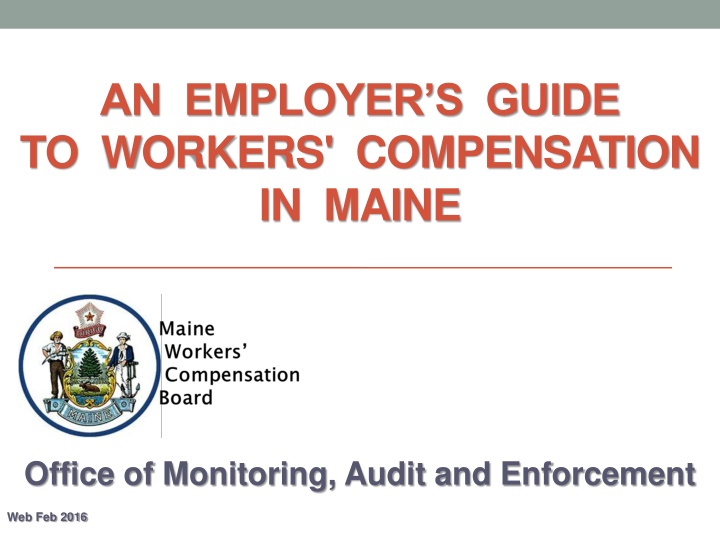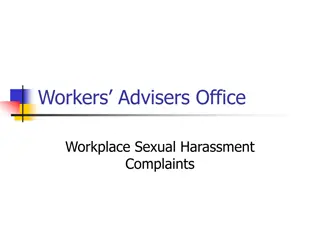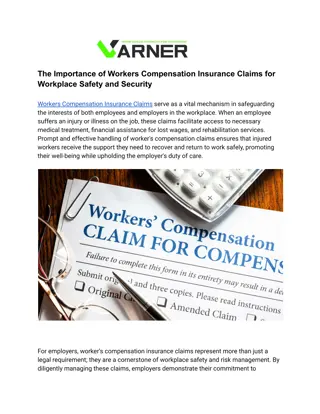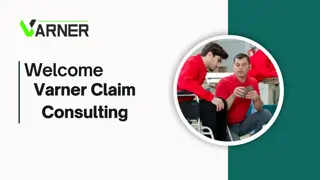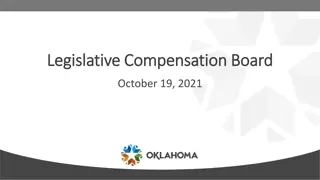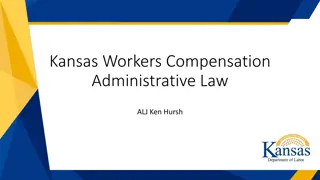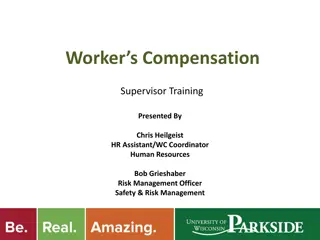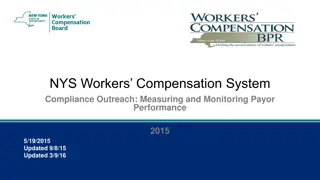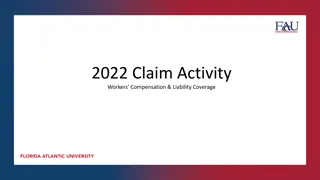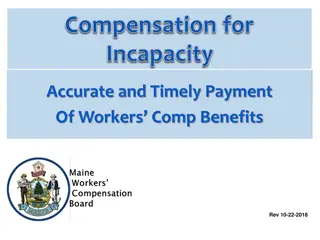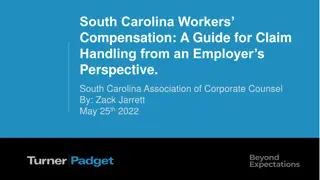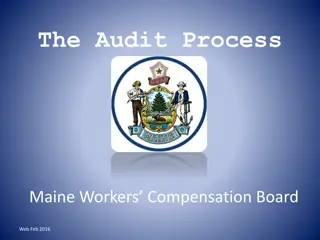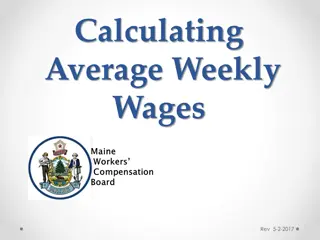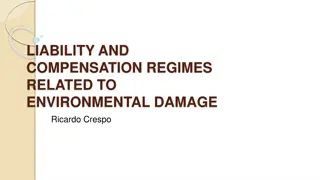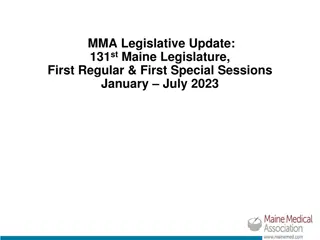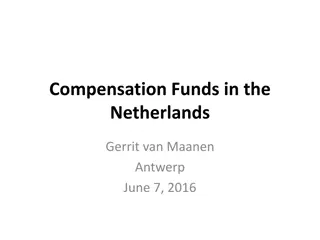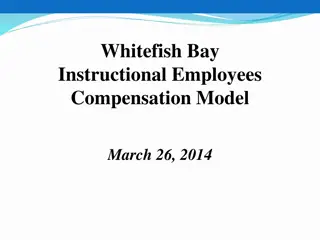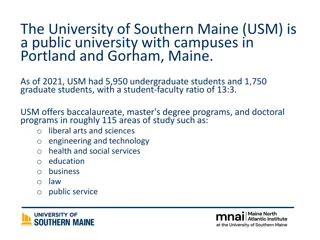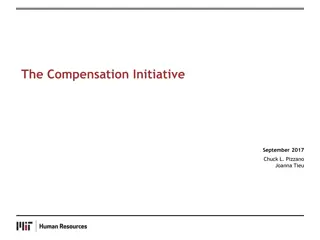Employer's Guide to Workers' Compensation in Maine - Overview and Resources
This comprehensive guide covers essential information about workers' compensation in Maine, including the role of employers, benefits of compliance, Maine Workers Compensation Board's mission, governance structure, regional offices, and key terms related to workers' compensation. It also provides insights into the Maine Workers Compensation Board's divisions and how the system works to ensure fair treatment for employees and employers while promoting dispute prevention and resolution.
Uploaded on Oct 04, 2024 | 0 Views
Download Presentation

Please find below an Image/Link to download the presentation.
The content on the website is provided AS IS for your information and personal use only. It may not be sold, licensed, or shared on other websites without obtaining consent from the author.If you encounter any issues during the download, it is possible that the publisher has removed the file from their server.
You are allowed to download the files provided on this website for personal or commercial use, subject to the condition that they are used lawfully. All files are the property of their respective owners.
The content on the website is provided AS IS for your information and personal use only. It may not be sold, licensed, or shared on other websites without obtaining consent from the author.
E N D
Presentation Transcript
AN EMPLOYERS GUIDE TO WORKERS' COMPENSATION IN MAINE Office of Monitoring, Audit and Enforcement Web Feb 2016
Workshop Agenda The Maine Workers Compensation Board Workers Compensation Terms How Does the WC System Work in Maine? What is the Employer s Role? What are the Benefits of Doing Things Right? Like To learn More? 1. 2. 3. 4. 5. 6.
MWCB Mission Statement The general mission of the Maine Workers' Compensation Board is to serve the employees and employers of the State fairly and expeditiously by ensuring compliance with the workers' compensation laws, ensuring the prompt delivery of benefits legally due, promoting the prevention of disputes, utilizing dispute resolution to reduce litigation and facilitating labor-management cooperation.
Maine Workers Compensation Board Governed by 7 member panel Appointed by the Governor 3 Appointees from the labor sector 3 Appointees from the management sector Executive Director - serves as the Board Chair (also serves as tie breaker)
MWCB Regional Offices Portland Lewiston Augusta 62 Elm St Portland, ME 04101 207-822-0840 1-800-400-6858 36 Mollison Way Lewiston, ME 04240 207-753-7700 1-800-400-6857 24 Stone St, Suite 102 Augusta, ME 04330 207-287-2308 1-800-400-6854 Bangor Caribou 1 Vaughn Place 43 Hatch Dr, Ste 110 Caribou, ME 04736 207-498-6428 1-800-400-6855 106 Hogan Road Bangor ME 04401 207-941-4550 1-800-400-6856
MWCB Divisions Claims Management Unit Coverage Division MAE Program Monitoring Division Audit Division Enforcement Division Abuse Investigation Unit
Workers Compensation Terms What is Incapacity ? Incapacity means the loss of a day s work. A day s work means the wages in an employee s regular work day (Rule 3.1.1), or Consecutive hours equal to the employee s regular work day (Rule 3.1.4).
Workers Compensation Terms What is an Insurer ? An insurer providing workers compensation insurance to the employer, or A self-insured employer that handles its own workers compensation claims, or A third party administrator who handles workers compensation claims for insurers or self-insured employers. Under the Maine Workers Comp Act, if the employer is insured, the term employer includes the insurer.
Workers Compensation Terms What is a FROI ? First Report of Occupational Injury or Disease WCB-1 A FROI indicates a workers compensation injury has allegedly taken place. A FROI must be completed for injuries that require medical treatment or for injuries that result in incapacity. The FROI is an OSHA approved form that captures employee and employer information, as well as information regarding the injury.
Workers Compensation Terms What is a MOP ? Memorandum Of Payment WCB-3 A MOP indicates when payments for incapacity begin. The Board reviews MOPs to determine if initial payments are issued in compliance with the Maine Workers Compensation Act.
Workers Compensation Terms What is a NOC ? Notice Of Controversy WCB-9 A NOC indicates that an insurer is denying benefits. A NOC is used for denying any or all types of benefits and for any reason including medical only and indemnity (lost time) benefits. All NOCs move the claim into the dispute resolution system (discussed later).
Workers Compensation Terms What is a Lump ? Lump Sum Settlement WCB-10 Monetary agreement between the parties to discharge the employer, in whole or in part, from future liability arising from the injury. Must be approved by the Board.
How Does the Workers Comp System Work in Maine?
How Does the WC System Work in Maine? Accident occurs Treatment is sought Employee recovers Back to work!
How Does the Workers Comp System Work in Maine? The employee must tell his or her employer or supervisor or someone from management that he/she was injured within 30 days of the injury. The employee is required to obtain health care from a provider of the employer s choosing for the first ten days of treatment. Changing healthcare providers after the first ten days requires the employee to notify the employer.
How Does the Workers Comp System Work in Maine? Sometimes people disagree about what happened, how things happened, or how to recover.
How Does the Workers Comp System Work in Maine? The Board uses a 3-tiered system to resolve disputed claims: Troubleshooting Mediation Formal Hearing
How Does the Workers Comp System Work in Maine? Troubleshooting Troubleshooting is an attempt to resolve disputes informally. A Troubleshooter (Claims Resolution Specialist) is engaged every time a NOC is filed. Parties are contacted to identify issues. If issues can t be resolved informally, and if the employee wants to pursue, it is referred to Mediation.
How Does the Workers Comp System Work in Maine? Mediation Mediation is a mandatory meeting between the employer and employee to attempt to resolve issues via a mediation agreement without going to formal hearing. A Board mediator moderates the meeting. Either or both parties may use representatives. Mediation defines issues in conflict and tries to facilitate remedies. If no consensus is reached, one party must file one or more petitions to move the case on to a formal hearing.
How Does the Workers Comp System Work in Maine? Formal Hearing Initiated by one or more petitions from any party (employee, employer, medical provider, etc.). A Board Hearing Officer (Administrative Judge) determines the disposition of the petitioned issues. Appeals can be heard through an Appellate Division made up of panels of no fewer than 3 full-time hearing officers.
What is the Employers Role? Successful administration of a claim is a delicate balancing act of information and communication.
What is the Employers Role? The opportunity for the successful administration of a claim starts with the employer. Take care of your employees and your organization! Employers have the responsibility to transfer all necessary information to the insurer ASAP. Insurers are under form filing and payment time lines.
What is the Employers Role? Statute of Limitations Claimant has 30 days to report the injury to the employer. 301- Indicates that claimants must give notice of the injury within 30 days after the date of injury. This is not a hard date, especially when 302 - Mistake of Fact comes into play (e.g.: soft tissue injuries.) Adopt a better safe than sorry reporting philosophy. Allow the Board dispute resolution system to resolve issues rather than decide not to fill out the FROI!
What is the Employers Role? FROI Instructions Report should be filled out as employee alleges the injury occurred. Employer s opportunity to dispute employee s claim lies within realm of dispute resolution system by filing a NOC, not by suppression of FROIs.
What is the Employers Role? Under 303 of the Act: FROIs are required to be filed within 7 days after the employer receives notice or has knowledge of an injury that resulted in an employee s incapacity. Filed means received and accepted at the Maine Workers Compensation Board. All FROIs and corrections or changes to FROIs must be filed via EDI (Rule 3.4).
What is the Employers Role? Under 303 of the Act: Medical Only (no incapacity) FROIs should be promptly reported to your insurer. There is no requirement to file Medical Only FROIs with the Board unless the claim is denied (NOC). Copy of the FROI must be sent to the employee.
What is the Employers Role? Lost Time FROIs filed electronically via EDI with the Board, with copies to: 1) employee, 2) insurer, and 3) employer Medical Only FROIs copies to: 1) employee, 2) insurer, and 3) employer
What is the Employers Role? Monitor Your Claims: When a Medical Only claim turns into a Lost Time claim, the FROI must be filed or updated via EDI with the Board within 7 days of the employer s notice or knowledge of incapacity. This may happen when an employee loses earnings because of the injury that equal or exceed a day of earnings. It may also happen when you are paying your employee for their missed time ( salary continuation ), but the employee loses consecutive hours equal to or greater than a regular work day or sporadic hours equal to or greater than a regular work week. ** Best practice recommendation: Report all lost time and lost earnings to your insurer.
What is the Employers Role? Wage Statements (WCB-2) are the employer s responsibility 303 - Reports to Board The employer shall also report the average weekly wages or earnings of the employee . . . -within 30 days after the employer receives noticeor has knowledge of a claim . . . (within 30 days of box 22 of the MOP, or box 20 of the NOC) Fringe Benefit Worksheets (WCB-2B) required beginning January 1, 2013
What is the Employers Role? Wage Statements Critical to successful administration of claim. Necessary to determine the employee s average weekly wage. The average weekly wage at the time of the injury determines benefits even if there is no incapacity for years! ** Best practice recommendation: Generate Wage Statement info whenever a Lost Time FROI is filled out.
What is the Employers Role? Wage Statements Must be filed with the Board within 30 days of employer s notice or knowledge of claim for compensation (within 30 days of box 22 of the MOP, or box 20 of the NOC) Copy to employee, insurer, and employer. Required on all Lost Time FROIs where employee has incurred more than 7 days of incapacity. Required on all Lost Time FROIs where a NOC has been filed to deny incapacity. Employer s responsibility, but insurers can be - and are - held liable for obtaining from employer.
What is the Employers Role? Wage Statements May be filled out in the same manner the employee is normally paid (weekly, bi-weekly, monthly, etc.) Actual weekly earnings needed for week of injury (week 52) and week of hire (if applicable) Any weeks with NO earnings should be indicated as zero Include bonuses, commissions, vacation pay, etc. Indicate payroll week-end date, not check issue date Estimated earnings are not accepted by the Board
What is the Employers Role? Fringe Benefits Worksheet (WCB-2B) Due within 30 days of employer s notice or knowledge of claim for compensation(same as wage statement) Fringes are added to the AWW if they are discontinued Includes employer cost of health/dental/life insurance, 401K, pension, education, etc., at the time of injury Does not include reimbursement to employee for expenses on behalf of employer (travel, lodging, etc.) Any fringe provided must also indicate if it continues, and indicate the weekly cost to the employer
What are the Risks of Doing Things Wrong? Lost Time FROI Reporting Obligation - 7 Days $100 fine applies to Lost Time FROIs that are filed later than 7 days beyond employer s notice or knowledge of incapacity. The Board may reduce the fine, depending upon the circumstances. Penalties may also apply to other late forms, such as the wage statement and fringe benefits worksheet.
What are the Risks of Doing Things Wrong? Late reports of lost time to insurers may result in late payments to employees. In addition to the hardship imposed on the employee, employers may be responsible for additional penalties of $50 per day up to $1,500 (under Section 205.3) for these late payments.
What are the Risks of Doing Things Wrong? A Complaint for Audit and/or a Petition for Penalties may be filed with the Board to investigate questionable claims-handling , repeated unreasonably contested claims or willful violations on one or more claims being handled by a specific insurer or employer. Can be filed by any party. Board staff investigates nature of complaint and determines scope of issues. May lead to audit of insurer s and/or employer s files to determine compliance with the Act. May lead to penalties under 359(2) of up to $25,000 and/or under 360(2) of up to $10,000.
Like To Learn More? The Maine Workers Compensation Board is committed to providing training assistance to insurers, self-insurers, third party administrators, and employers. It offers two day Open Training sessions in Augusta in January, April, June, and October. It also does on-site training on specific topics. It maintains training modules and other materials on its web site www.maine.gov/wcb/. It also maintains a booth at various trade shows, and can provide a speaker for your functions. Please contact the Board for more information!
MWCB Web Site www.Maine.gov/wcb/ Laws, rules, forms Compliance reports EDI information Newsletters Training modules Regional office locations
Board Contacts Seanna Crasnick, Deputy General Counsel and MAE Unit Supervisor, MWCB 207-287-8496 Seanna.Crasnick@Maine.gov Gordon Davis, Director of Audits 207-287-6327 Gordon.Davis@Maine.gov Kimberly Ward, Secretary Associate 207-287-7067 Kimberly.Ward@Maine.gov
